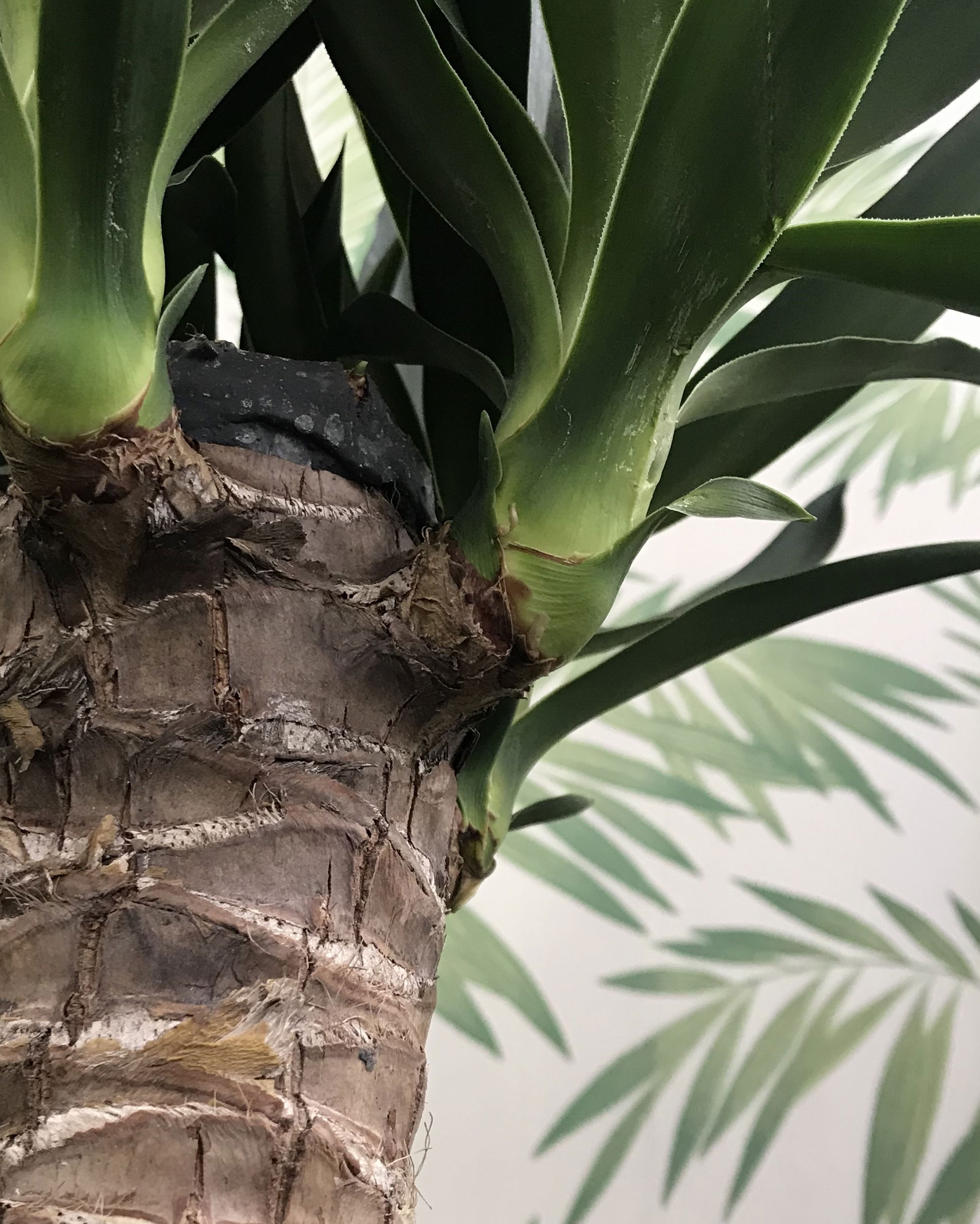
Yucca gigantea
Listen to the Yucca Podcast here!
Contents
- Top Tips
- Location, Water, Humidity & Fertilisation
- Common Issues
- Origins, Temperature, Propagation, Repotting & Toxicity.
Are you struggling to find the answer to your specific plant issue? Book a 1-to-1 video call with THE HOUSEPLANT DOCTOR™, the website's friendly author, to put an end to your stress today! Available on iMessage, WhatsApp, Facebook Messenger & more.
Top Tips & Info
- Care Difficulty - Easy
- Provide a few hours of morning or evening sun a day, avoiding the risk of sun scorch during the height of summer.
- Allow the majority of the soil to dry out in between waters, especially during the autumn and winter months to downplay the increased chance of root rot and over-watering.
- Fertilise using a 'Houseplant' or 'Cactus' labelled feed every four waters in the spring and summer, reducing this to every sixth water in the colder months.
- Yellowing lower leaves are the direct result of too little light and/or over-watering. Scroll down to ‘Common Issues’ for more information.
- Repot every three years using a well-draining potting mix (we'd recommend a 'Cactus & Succulent' compost to prevent over-watering).
Location & Light - 🔸🔸🔸
Never place a Yucca in a location where you can't read a newspaper, as typical signs of excess darkness are stunted growth, a pale foliar crown and yellowing lower leaves. The ideal setting for this plant is somewhere that can offer a few hours of morning / evening sun, or at least with over-head lighting. A bright, warm conservatory is best, or within a few metres of a south-facing window. Never situate one in a north-facing room, especially in the autumn and winter months, as there won't be enough light during the day.
Water - 🔸
As less is more with Yuccas, be sure to allow at least half of the soil to dry out in between waters. It's recommended to either use fresh bottled water, or tap water that has been allowed to sit for at 24hrs before application. This is purely on the basis of reducing the count of fluoride, which can damage the root system over the course of a few months and is commonly found in tap water to preserve hygiene. In terms of the frequency of irrigations, the season and light levels will directly govern the amount of waters per month. Specimens placed in darker areas must endure periods of near-droughts, whereas sunnier locations will require only the top half of the soil to dry out. Under-watering symptoms include entirely yellow/brown leaves, stunted growth and greying leaves; these issues are usually down to too much light/heat or forgetfulness, but is rather uncommon among gardeners. Over-watering symptoms include spotty brown leaves with yellow perimeters and a rotting stem. Yuccas will only thrive in a bright setting; locations that are too dark will significantly increase the chance of over-watering and yellowing lower leaves.
Humidity - 🔸🔸
Average room humidity is more than enough to accommodate this species. Never situate a Yucca within a few metres of an operating radiator due to the enriched chance of browning leaf-tips though.
Fertilisation - 🔸
If you're someone who forgets to supplement their plants during the year, this is the plant for you. Fertilise your specimen every four waters in the growing period, reducing this to every sixth water in the autumn and winter with a 'Houseplant' or 'Cactus' labelled feed. Never apply a 'Ready-to-Pour' fertiliser into dry soil without a pre-water beforehand, as this will significantly increase the risk of root-burn, with typical signs including yellowed leaves, elongated or poor growth and a general decline of health.
Common Issues with Yuccas
Soft yellowing lower leaves with soil remaining moist for long periods of time - A gradual loss of lower leaves is the natural part of ageing, but if there's evidence of heavy soil with yellowed foliage, remove its pot (leaving the rootball untouched) in a brighter location to aerate the soil. Root rot is the breakdown of roots when its soil has remained overly-saturated for long periods of time, suffocating them of oxygen and air circulation. Without immediate action, you'll run the risk of total destruction as the rot will slowly make its way up to the plant's base.
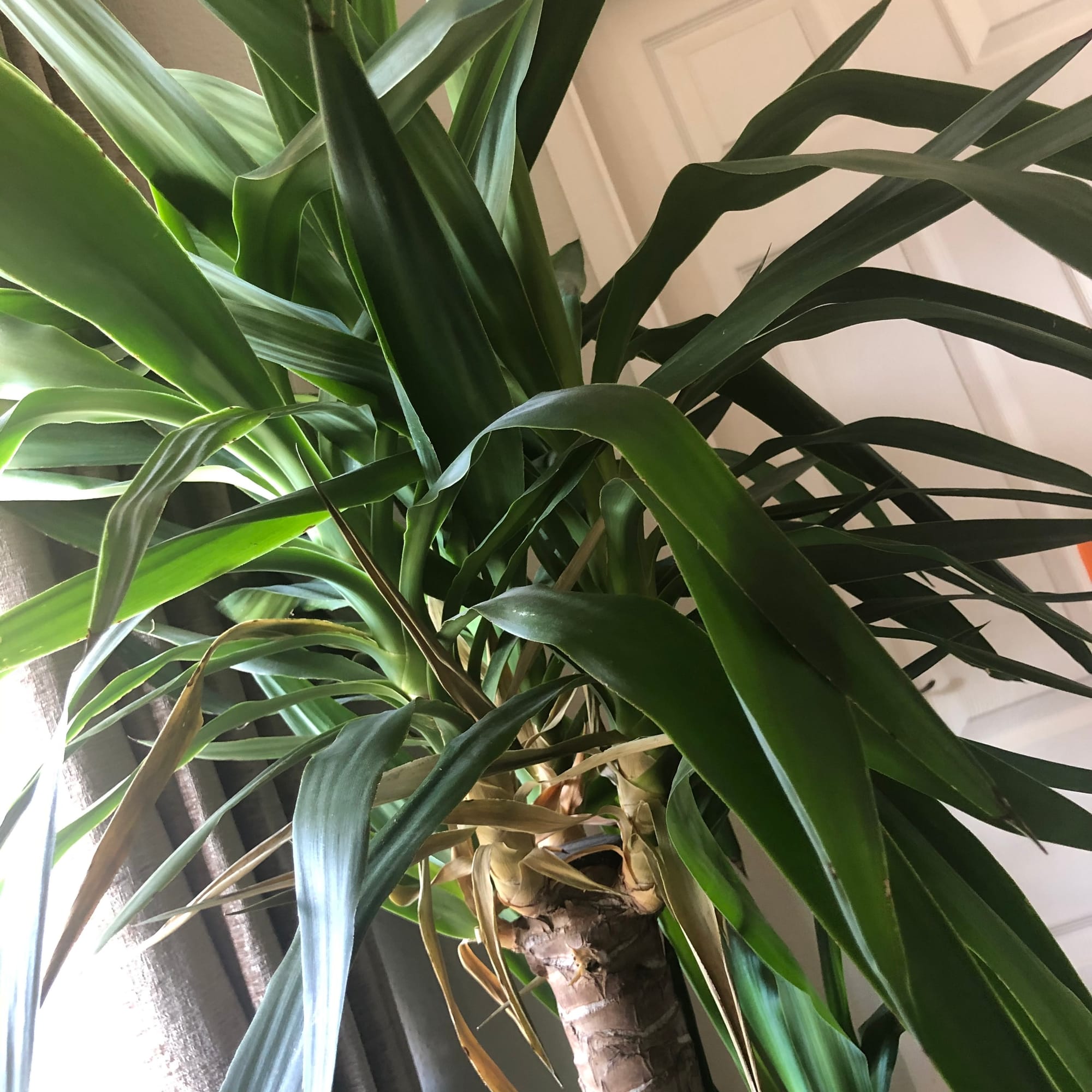 Alternatively, Yuccas that have crispy or hardened yellowing older leaves could be the result of dehydration. If the soil is either clumped together or dusty/dry, we recommend increasing your watering regime slightly to promote new foliage growth on the top. Your Yucca shouldn't die from dehydration though!
Alternatively, Yuccas that have crispy or hardened yellowing older leaves could be the result of dehydration. If the soil is either clumped together or dusty/dry, we recommend increasing your watering regime slightly to promote new foliage growth on the top. Your Yucca shouldn't die from dehydration though!
White leaf-edges, along with a 'washed-out' appearance, are the result of too little water and over-exposure to the sun (image below). Although Yuccas can naturally do well in sun-filled locations, those that haven't acclimatised to the harsh rays will show signs of sun-scorch and environmental shock. Gradually increase the amount of light every few days, starting from an indirect location to a few hours of morning/evening sun over a few weeks. Prolonged exposure will significantly speed the process of dehydration, so consider transplantation into a bigger pot in the spring to wrap the roots around moister soil.
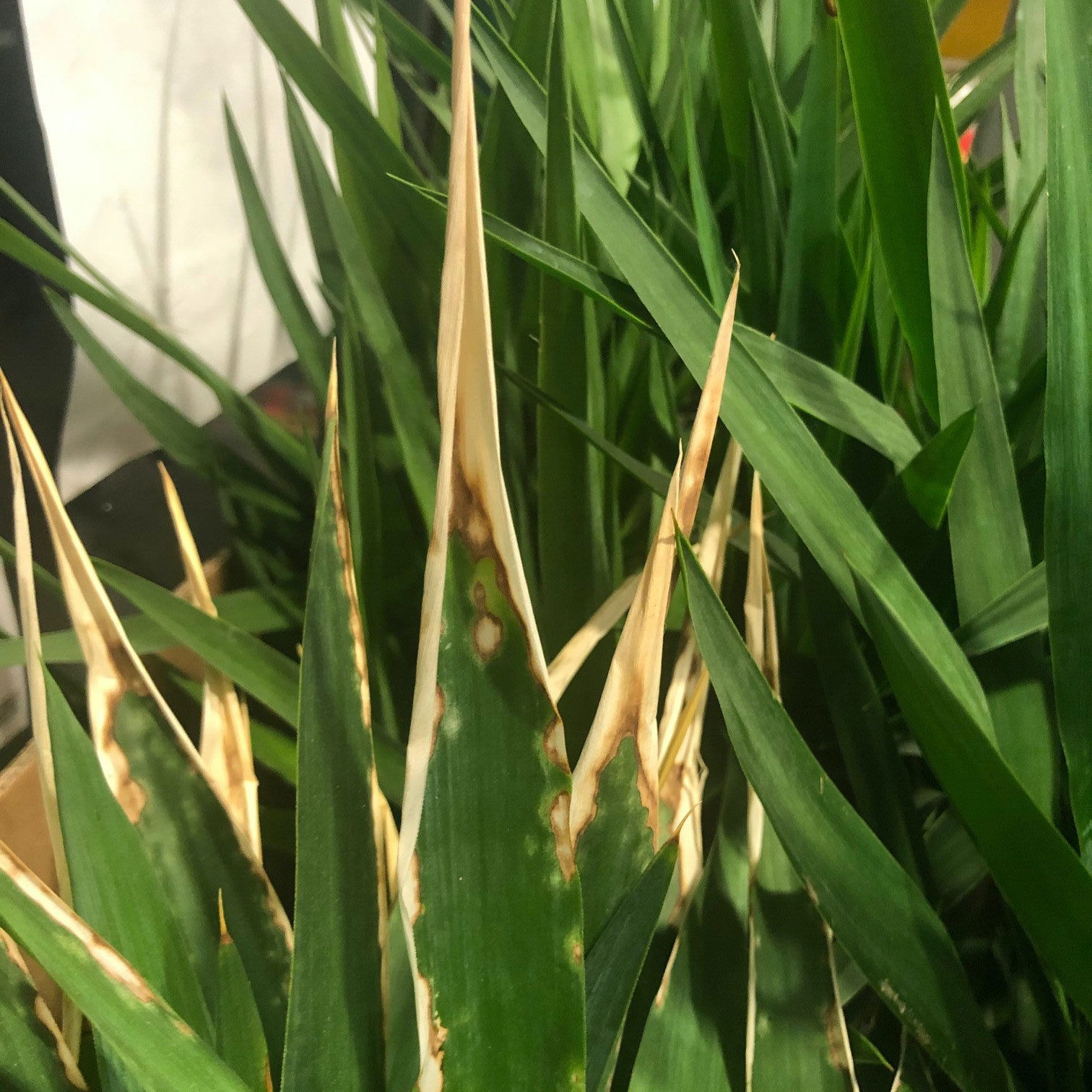 A typical symptom of sun-scorch. Click on the image to learn more on dealing with this issue.
A typical symptom of sun-scorch. Click on the image to learn more on dealing with this issue.
Too low humidity can cause browning leaf tips with yellow halos. Although this won't kill your specimen, you may want to increase the local moisture to prevent the new growth from adopting these symptoms. Mist or rinse the foliage from time to time and create a humidity tray whilst the heaters are active to create a stable environment for your specimen.
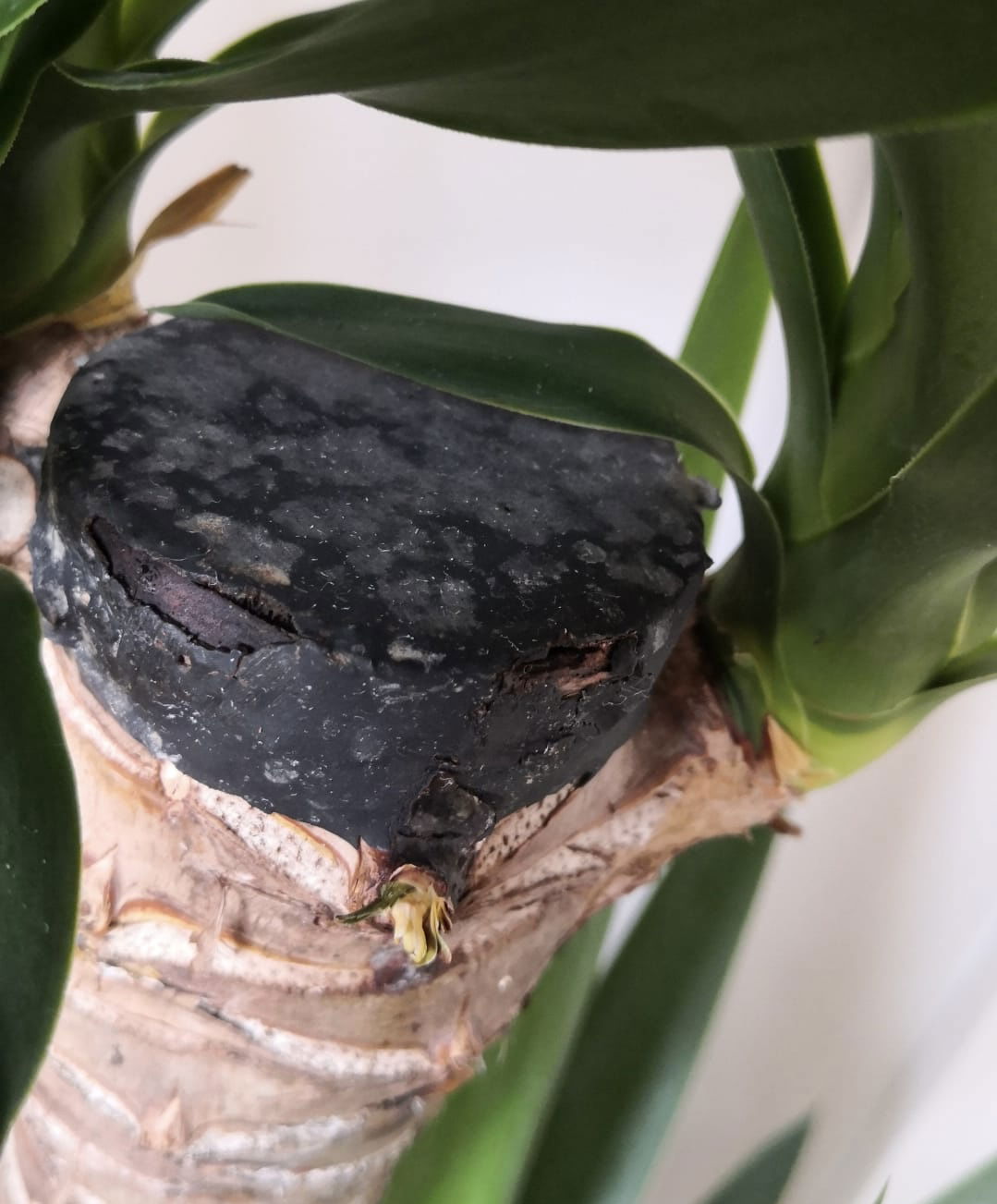 Ever wondered what the black rubbery stuff is on your Yucca? It's a special wax that helps callous (dry) the wound over to avoid disease when recently propagated in the commercial nurseries. Note: Don't remove this from the stem. The white dust-like covering on the wax is not powdery mildew.
Ever wondered what the black rubbery stuff is on your Yucca? It's a special wax that helps callous (dry) the wound over to avoid disease when recently propagated in the commercial nurseries. Note: Don't remove this from the stem. The white dust-like covering on the wax is not powdery mildew.
Small, brown spots are typical traits of over-watering. Coupled with root rot, leaf-spot disease is an issue among specimens that are situated in too little light with too much soil moisture. Click on the link to learn about how to address this issue.
If the bark feels 'loose' or can be easily pulled from the stem, this may be an issue of root rot (from over-watering) where the disease has travelled up the stem. Although there's nothing that can be done to save the mother plant, you'll still be able to take stem cuttings to keep the plant's 'legacy' alive. Scroll down to 'Propagation' below to learn more.
Spider Mites are small, near-transparent critters, that'll slowly suck out the chlorophyll out of the leaves. Have a check under the leaves, most notably along the midrib, for small webs and gritty yellow bumps. Click here to read our article about the eradicating Spider Mites, along with some extra tips that you may not find elsewhere!
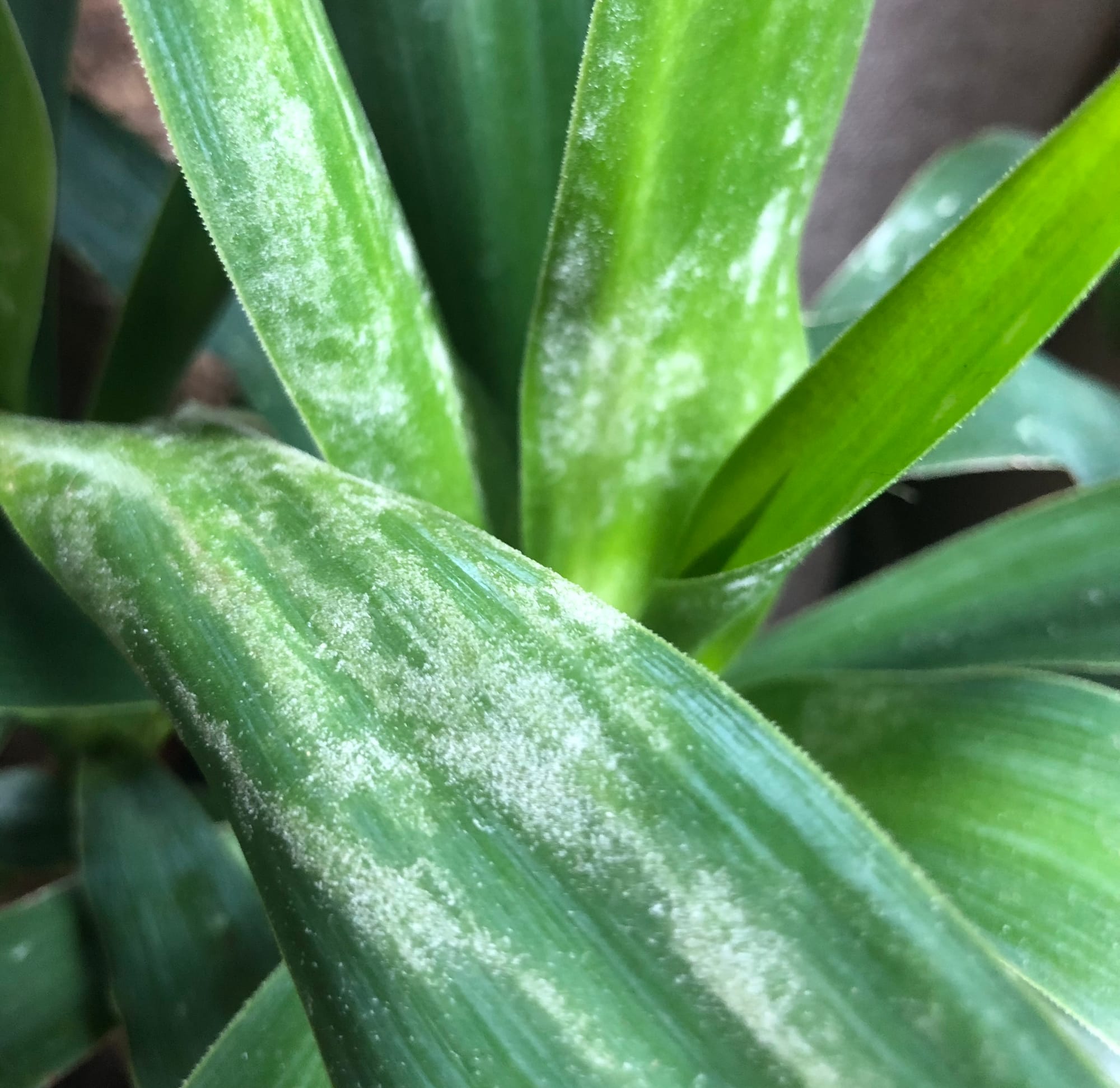 Powdery mildew is a white dust-like powder that'll cause havoc with your Yucca if left untreated. Purchase a fungicide from a local garden centre/store and take action as soon as possible. Click on the image to learn more.
Powdery mildew is a white dust-like powder that'll cause havoc with your Yucca if left untreated. Purchase a fungicide from a local garden centre/store and take action as soon as possible. Click on the image to learn more.
Transplant shock is a big issue when it comes to heavy-handed repots. Give the plant a good soak 24hrs before the action and never tinker with the roots, unless it has been affected by root rot. Typical signs of transplant shock are largely similar to under-watering, with wilting, yellowing leaves and stunted growth among the most common symptoms. Click here to learn more about addressing transplant shock, and a step-by-step guide on performing the perfect transplant.
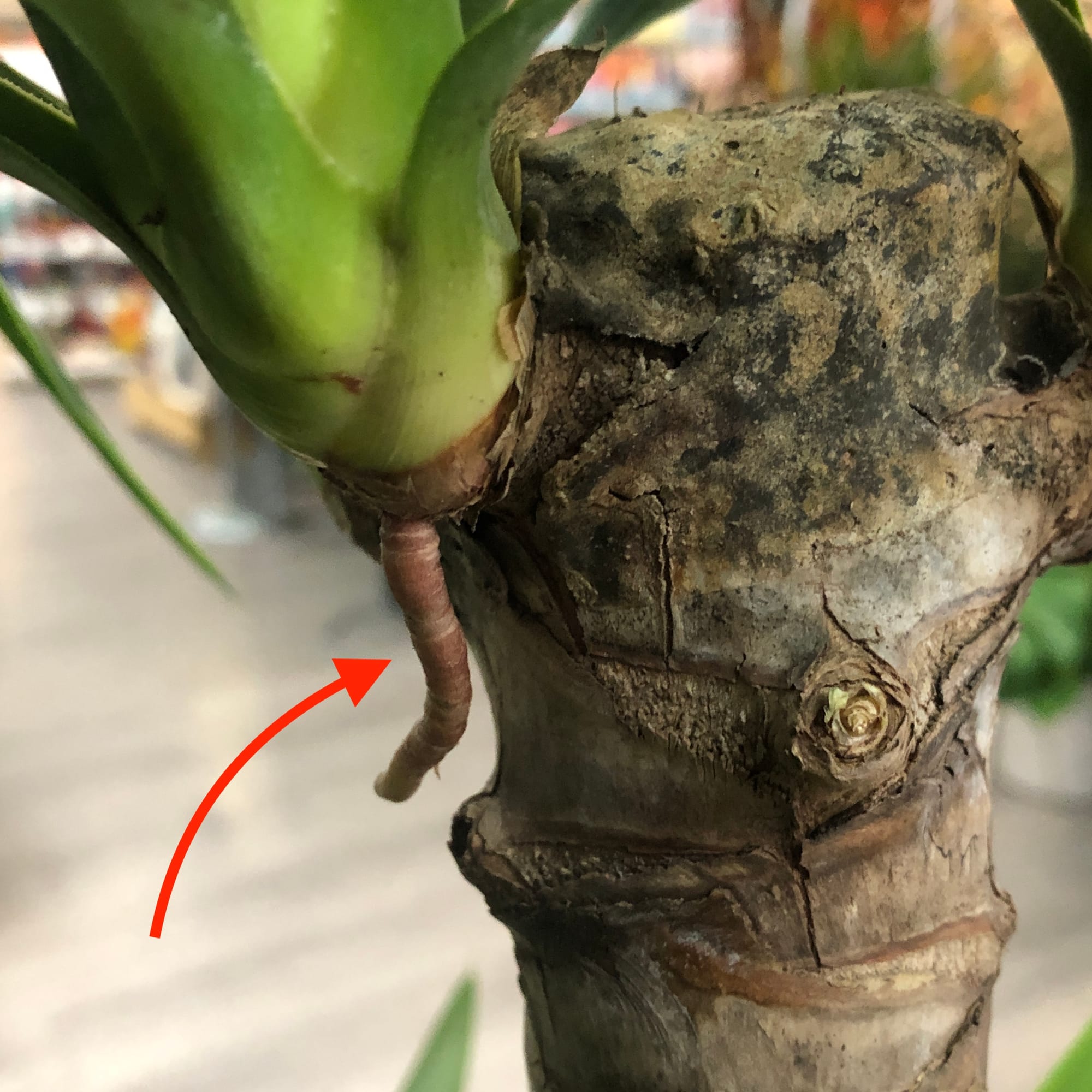
You may be wondering what these small orange/brown dangly bits could be as they're rather unusual. Well, fear not as they are simply just aerial roots that have formed along your Yucca's stem. Although you can safely prune them off, they won't cause any issues with the plant's overall health, so it's best to live and love them.
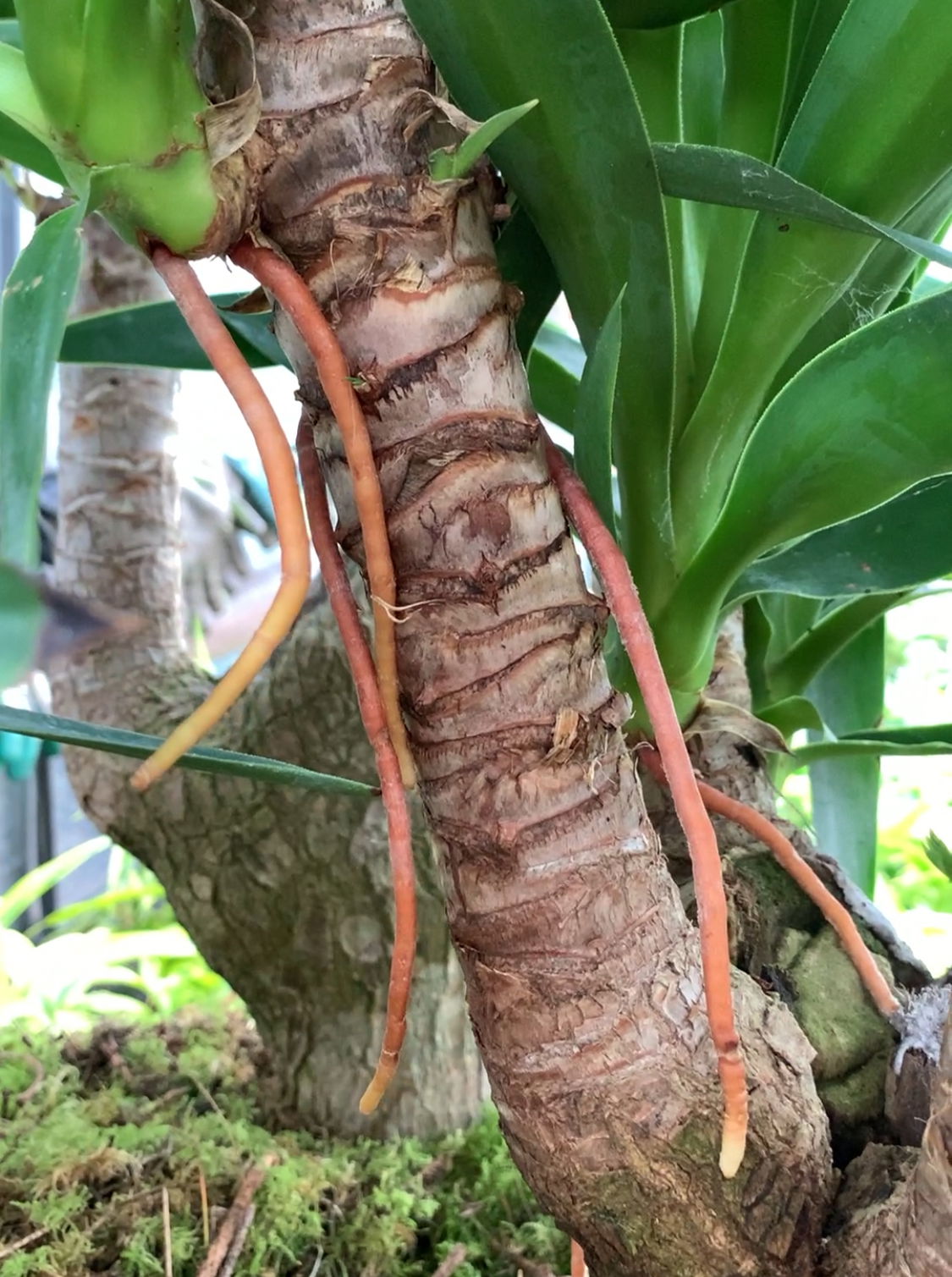
Here is another great example of a Yucca's aerial root. If yours has developed these, the chances of a stem cutting rooting is very likely, so feel free to do this (if you're interested in having another Yucca in the house). Scroll down to 'Propagation' to learn more on how to take Yucca cuttings.
If your specimen is located in a dark environment, use a chopstick to gently stab the soil in various areas. You should aim to enter the compost between the base of the plant and the pot's edge, as failure to do so may lead to damaging its lower portion. Leave the holes open for a few days before re-surfacing the compost to avoid it becoming overly dry. Not only will the gentle shift in the soil's structure mimic the work of small invertebrates in the wild (worms, etc.), but it'll also add oxygen back into the soil, thus reducing the risk of root rot. Repeat this monthly, or whenever you feel the potting-mix isn't drying out quickly enough.
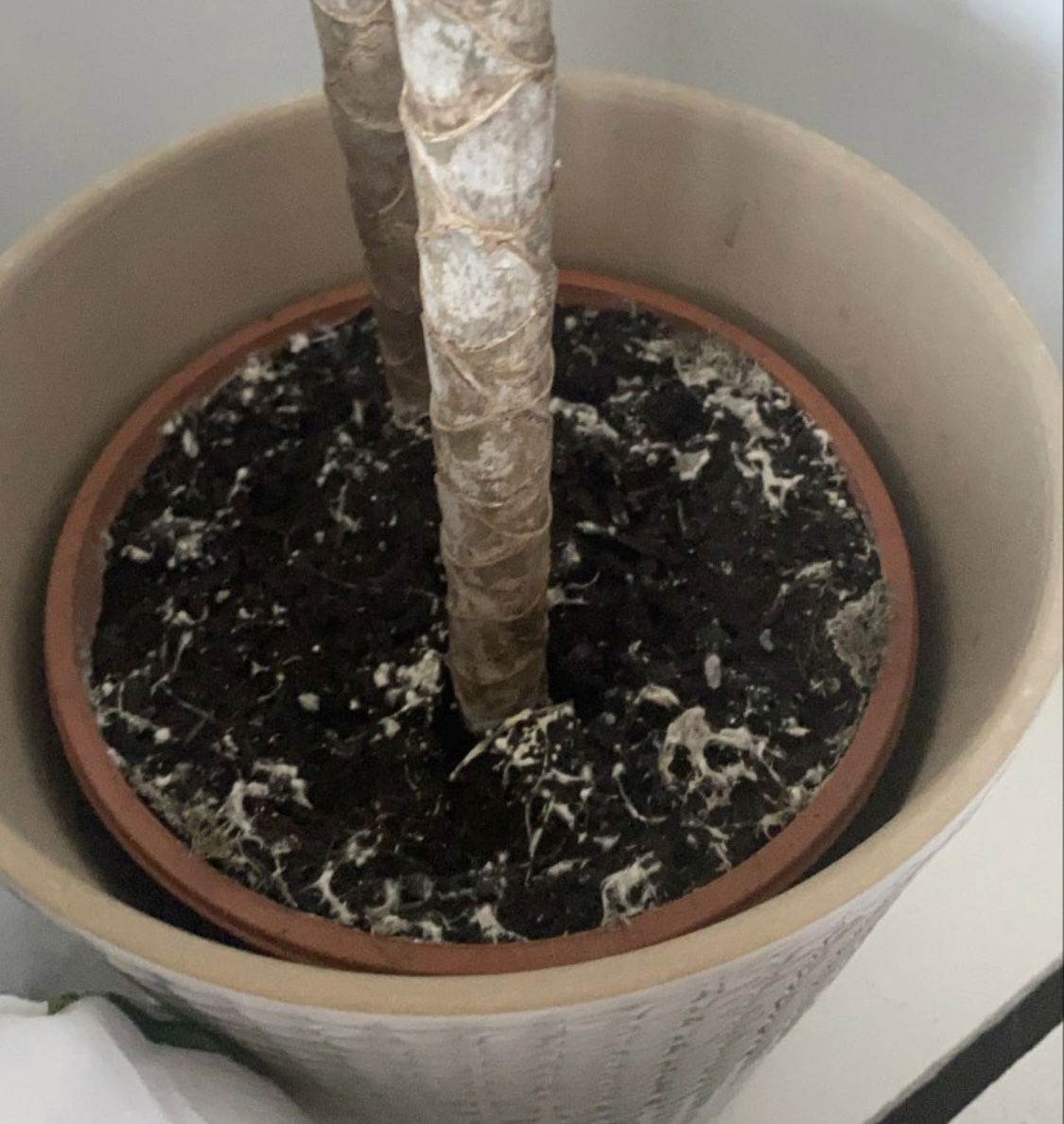 Although it won't hurt your Yucca, mould growing on the soil indicates you're watering too often. Replace the top two inches of soil with a fresh batch of 'Houseplant' labelled potting mix and remember allow it to slightly dry out in between irrigations.
Although it won't hurt your Yucca, mould growing on the soil indicates you're watering too often. Replace the top two inches of soil with a fresh batch of 'Houseplant' labelled potting mix and remember allow it to slightly dry out in between irrigations.
The final issue to mention is the death of smaller trunks when arranged in a 'trio' of one pot (image below). Although this is a common issue among horticulturalists, this shouldn't happen. The obvious cause could be over-watering and if the soil has been rather heavy for a long period of time, think about relocating it to a drier, brighter environment with an inspection for root rot. In some cases, it may be to do with too little light and not enough water. As Yuccas tend to have smaller root systems (similar to the Dracaena), their root systems won't penetrate the soil enough, thus leading to dehydration and death. If this has happened to you, be sure to remove the trunk once it fully dies off, as leaving it may cause a spread of disease. Book a 1-to-1 video call with THE HOUSEPLANT DOCTOR™ if you're still stuck with what to do next.
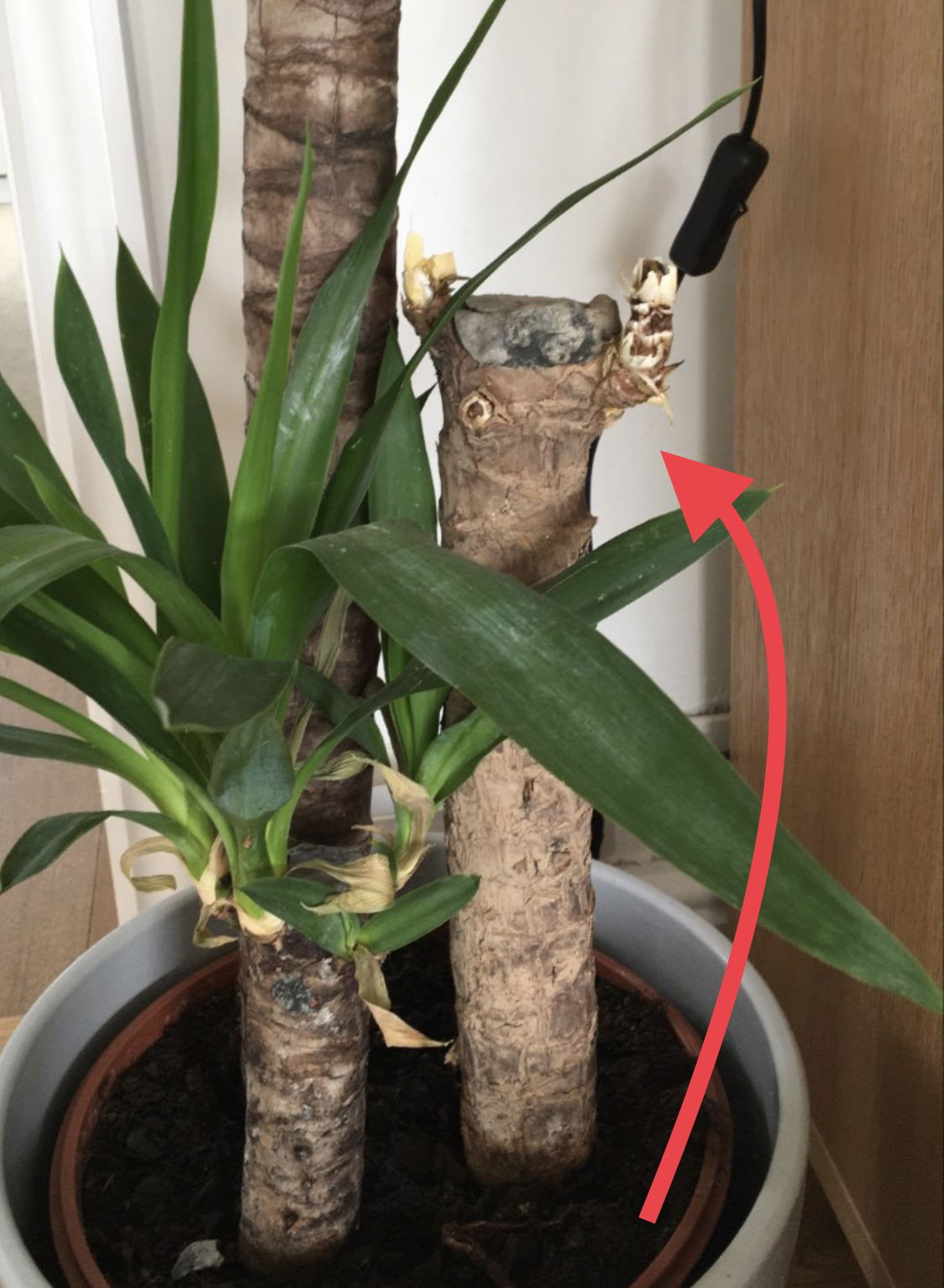 It's very common for one of the individual Yuccas to die when bought as a trio in a garden centre/store. In some cases, this is the product of root rot through over-watering). (See paragraph above for more info for a remedy).
It's very common for one of the individual Yuccas to die when bought as a trio in a garden centre/store. In some cases, this is the product of root rot through over-watering). (See paragraph above for more info for a remedy).
Origins
The Yucca gigantea was first formally described in 1859 by a French botanist named Charles Lemaire. Although this is the official name of the species, some still refer it to Y. guatemalensis, which was named by Baker in 1872, or E. elephantipes due to its thickened stems when cultivated in Europe. The flower, Izote, is the national flower of El Salvador. The species primarily originates from central America but has been introduced in other semi-arid climates around the world within the last century.
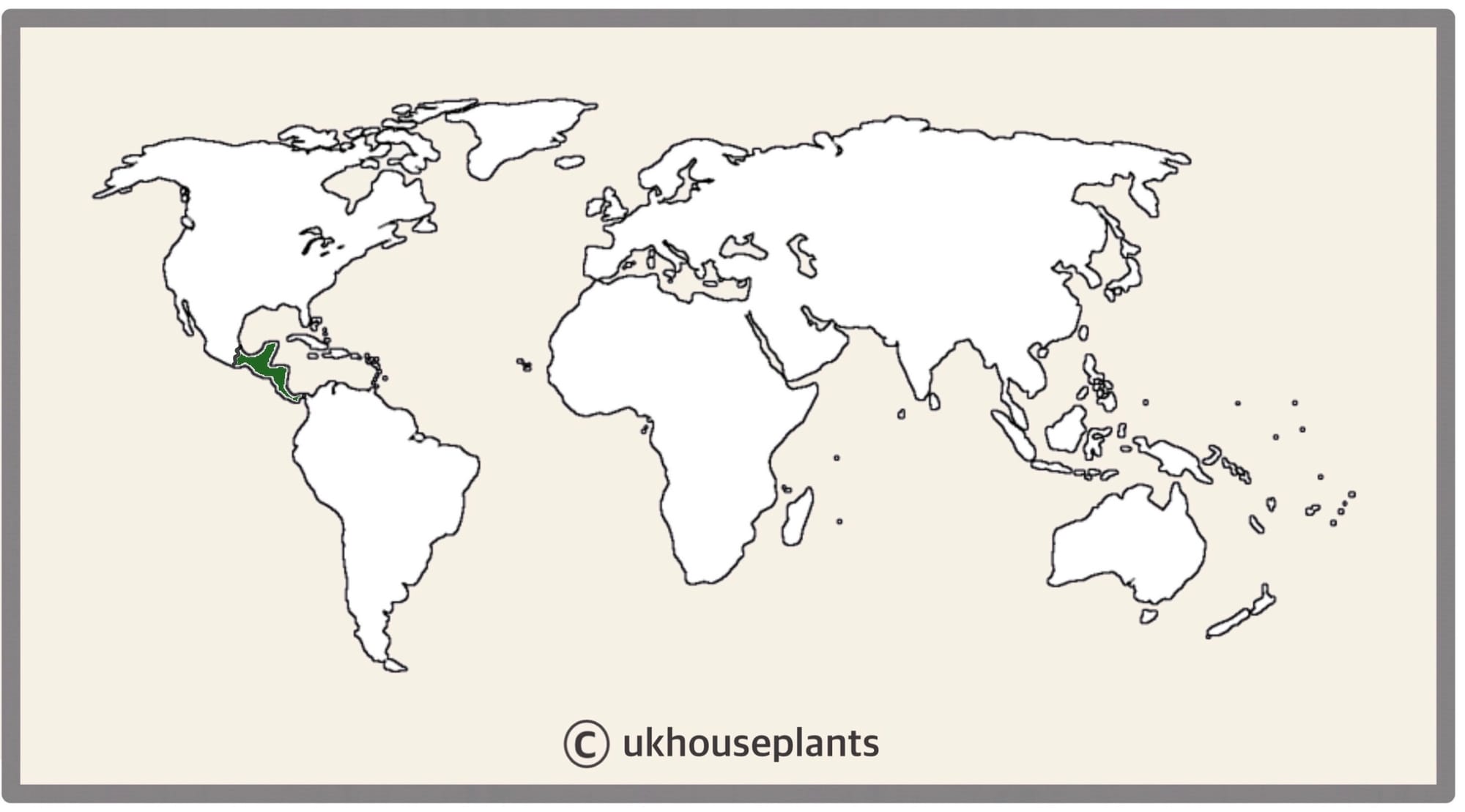 The Distribution of Yucca elephantipes (E. gigantea)
The Distribution of Yucca elephantipes (E. gigantea)
Temperature
10° - 32°C (50° - 90°F)
H1c (Hardiness Zone 11) - Can be grown outdoors between late spring and summer throughout most of the UK while nighttime temperatures are above 10℃ (50℉). If you decide to bring the plant outdoors, don't allow it to endure more than an hour of direct sunlight a day as it may result in sun-scorch. Regularly keep an eye out for pests, especially when re-introducing back indoors.
Spread
Over 2m in height and 0.7m in width once they reach maturity. The ultimate height will take between 5 - 10 years to achieve, with 15cm of growth being put out per year.
Pruning & Maintenance
Remove yellowed or dying leaves and plant debris to encourage better growth and all-round appearance. Pruning must be done with clean scissors or shears to reduce the chance of bacterial and fungal diseases - remember to make clean incisions as too much damage can shock the plant.
Propagation
Via Seeds, Stem Cuttings & Sucker Seperation.
Stem Cuttings (Easy) (Image Below) - Taking stem cuttings can be done either to reduce the overall height of your Yucca, or for 'saving' part of the plant's stem due to root rot below. Either way, we recommend aiming to prune off at least 16cm (6 inches) from the very top of the stem with foliage. (Have a look at the image below for an ideal specimen). Place the stem section in water until roots emerge after six weeks. Once they are around 5cm (2 inches) in length, pot the cutting into a 10cm plastic pot with 'Houseplant' labelled potting mix and water once a week. Ensure the cutting is in a warm, bright sunless windowsill and feed every third water until mature (three months).
Basal Offsets (Easy to Moderate) - Your mature plant will eventually produce small basal offsets (known as 'pups') within a few years of ownership. Although we'd recommend keeping them attached to the mother plant, you can propagate them once they have grown at least ten leaves each.
Remove the mother plant's pot and place your hand in between the junction that connects the two; soil can be brushed away to get a better grip. Gently push the offset/pup downwards while supporting the mother plant until you hear a snap. Cautiously separate the root systems, keeping great care in keeping them damage-free; remember, the more roots it has, the quicker the regrowth will be. Place the new plantlet in a 7cm pot with 'Houseplant' potting mix, ensuring all of the leaves are still above the soil line. Provide a similar location to what the plant is used to, or an equally bright windowsill with temperatures around 20°C (68°F) with the majority of the soil remaining moist in between waters. Once the cutting begins to produce new leaves (usually within two months), you can treat it as a mature specimen by following our cultivation tips above.
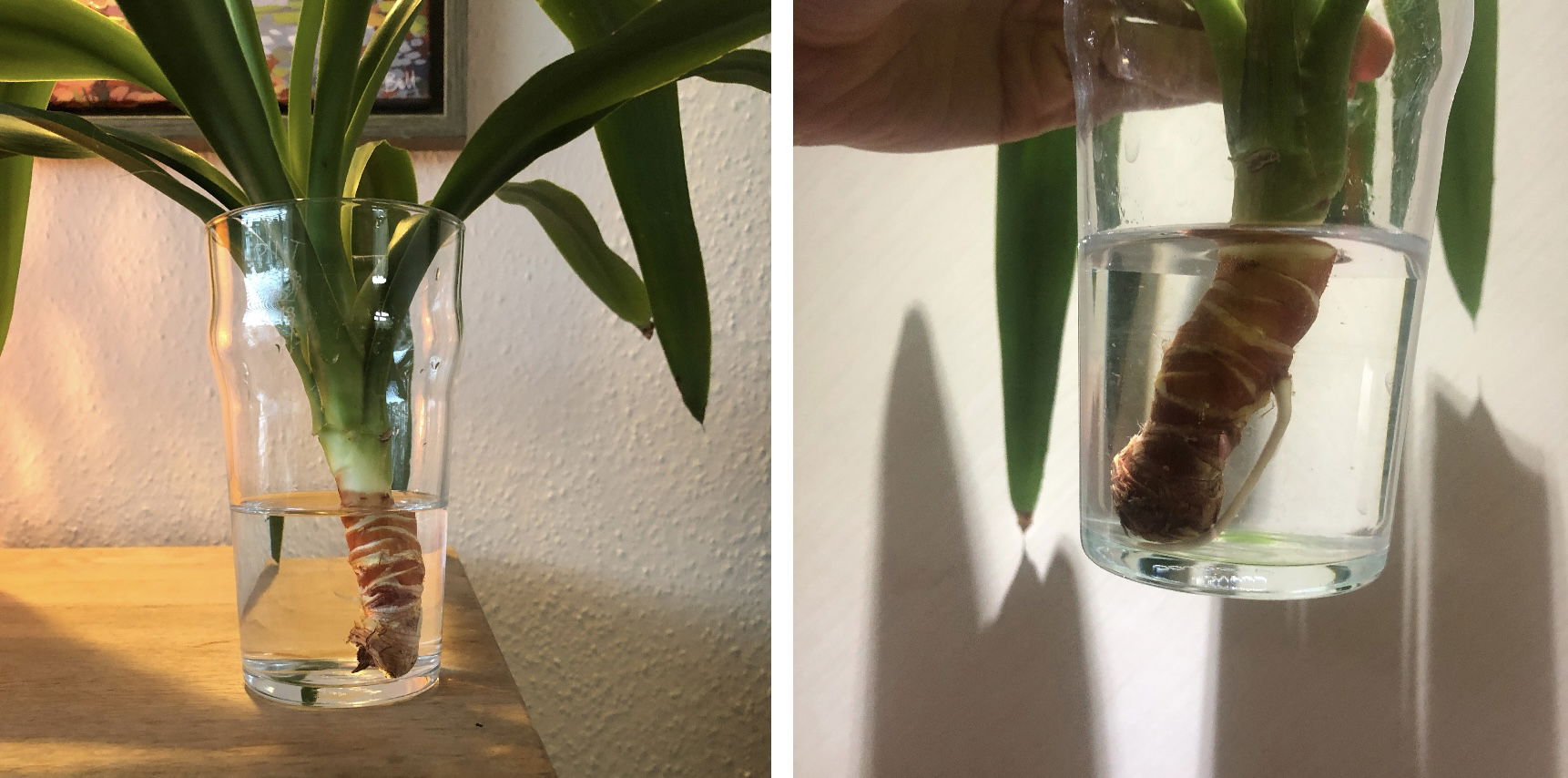 Left: The ideal size for a Yucca stem cutting. Right: Root development after six weeks.
Left: The ideal size for a Yucca stem cutting. Right: Root development after six weeks.
Flowers
The time in which it takes Yuccas to flower greatly depend on its level of maturity and its growing conditions. If the dormancy period is served well during winter, white flowers arranged in panicles will develop high above the foliage, lasting several weeks.
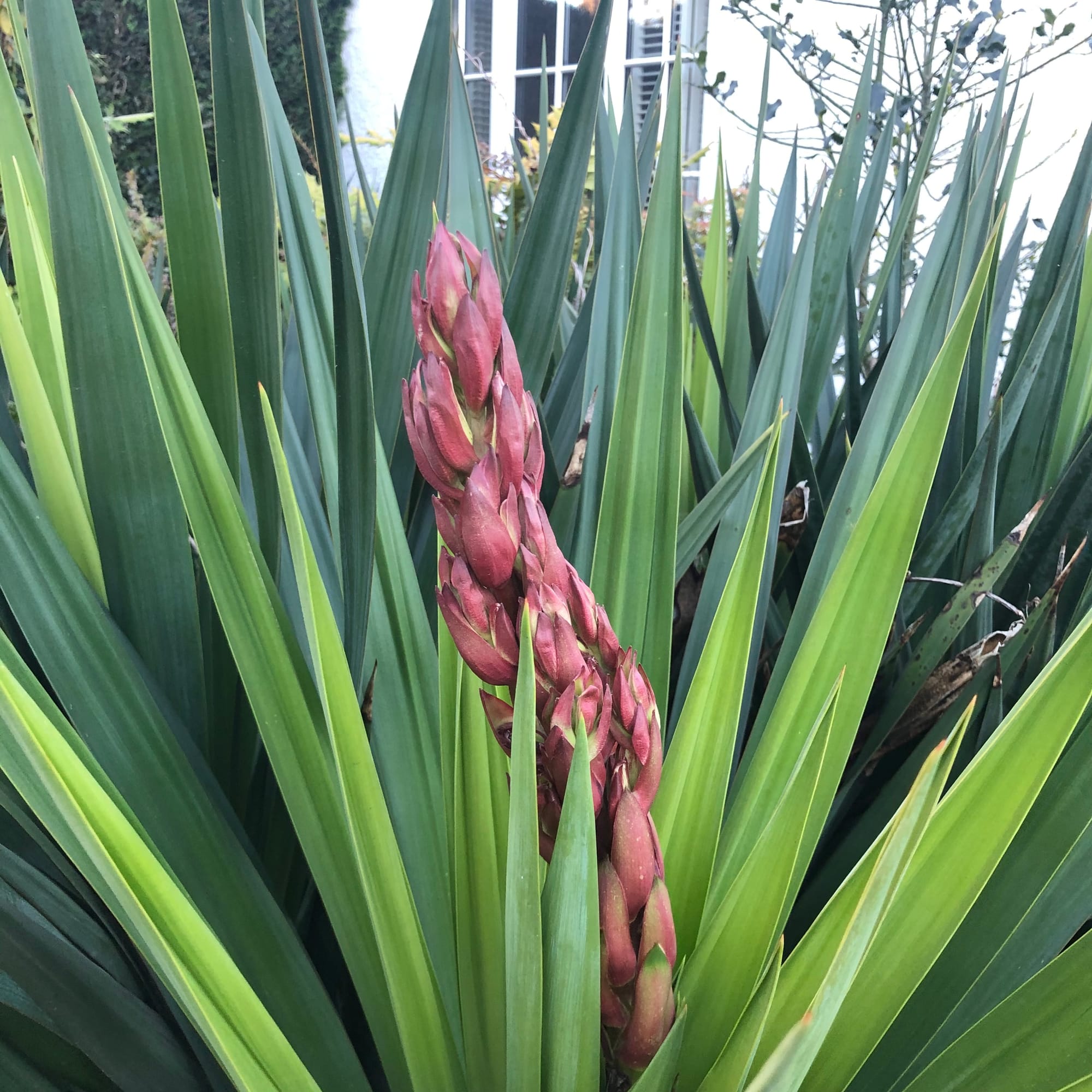 A developing cluster of flowers that'll begin to emerge in around two week's time.
A developing cluster of flowers that'll begin to emerge in around two week's time.
Repotting
Repot every three years in the spring using a 'Cactus & Succulent' Compost and the next sized up pot. Whilst transplanting your Yucca, be sure to support the stem of the plant as they're top-heavy and prone to toppling over. For matured specimens, introduce more grit to promote a stronger root ball - hit this link for more information on how to perform the perfect transplant.
Book a 1-to-1 video call with THE HOUSEPLANT DOCTOR™ if you'd like a personal guide to repotting your houseplant. This will include recommending the right branded-compost and pot size, followed by a live video call whilst you transplant the specimen for step-by-step guidance and answer any further questions.
Pests & Diseases
Keep an eye out for mealybugs, spider mites, scale, thrips, whitefly & vine weevils. Typical diseases associated with Yuccas are root rot, leaf-spot disease, botrytis (grey mould) & powdery mildew - click here to learn about these issues.
Toxicity
This plant is classified as poisonous due to the concentration of 'steroidal saponins' in its stems. If parts of the plants are digested by a child or pet, vomiting, nausea and a loss of appetite could occur. Consumption of large quantities must be dealt with quickly; acquire medical assistance for further information.
Note: Its leaves' edges are also razor sharp so always wear protective gloves and clothing when handling.
Retail Locations
IKEA, Dobbies, Online Stores.
Book a 1-to-1 Call with THE HOUSEPLANT DOCTOR™
If you need further advice with your houseplants, book an advice call with ukhouseplants' friendly and expert writer today! This can be done via a video or audio call on most apps, including Facebook, FaceTime & Skype. A ten-minute call costs £5.99 (US$7), or £15.99 for thirty minutes. You can ask multiple questions, including queries on plants, pests, terrariums, repotting advice and anything in between. Please consider supporting this service to keep ukhouseplants thriving!